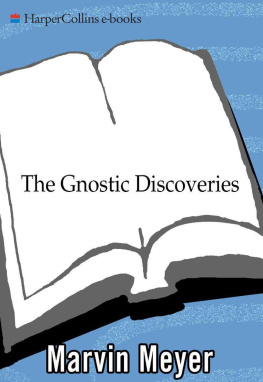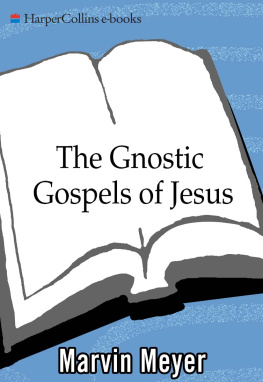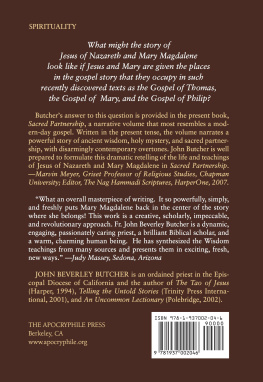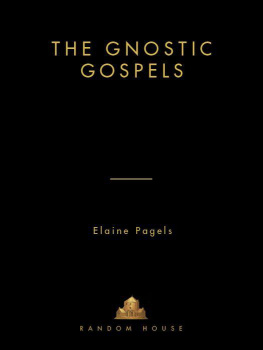Contents
Gnostic Wisdom: Ancient and Modern
Fertilizer, Blood Vengeance, and Codices
The Discovery of the Nag Hammadi Library
Coptic Texts from the Sands of Egypt
The Nag Hammadi Library and the Berlin Gnostic Codex
They Will Not Taste Death
The Wisdom of the Living Jesus in the Gospel of Thomas and Thomas Texts
The Wisdom of Insight
The Fall and Restoration of Sophia in the Secret Book of John and Sethian Texts
Valentinus the Christian Mystic
Salvation Through Knowledge in the Gospel of Truth and Valentinian Texts
Hermes, Derdekeas, Thunder, and Mary
Revealers of Wisdom in Other Nag Hammadi Texts
Discoveries After the Nag Hammadi Library
The Texts of the Nag Hammadi Library and the Berlin Gnostic Codex
G NOSTIC W ISDOM A NCIENT AND M ODERN
S INCE THE DISCOVERY of the ancient texts that comprise the Nag Hammadi library, the world of the historical Jesus, the schools of Judaism and Greco-Roman religion, and the varieties of Christianity has begun to look remarkably different than it did once upon a time.
In this book, The Gnostic Discoveries, I seek to assess the character of that world of Jesus, Judaism, Greco-Roman religion, and early Christianity in the light of the Gospel of Thomas, the Secret Book of John, the Gospel of Truth, and other texts unearthed in the discovery of the Nag Hammadi library and to suggest the extent to which a new understanding of that ancient world may impact our modern world.1 Many of the texts found in the Nag Hammadi library and related collections, such as the Berlin Gnostic Codex, represent a mystical spirituality commonly called gnosticism, a term derived from the Greek word gnosis, knowledge.2 Hence the title of this book.
B EFORE THE N AG H AMMADI L IBRARY
Prior to the discovery of the Nag Hammadi library, gnosticism typically was considered to be an early and pernicious Christian heresy, and much of our knowledge of gnostic religion was gleaned from the writings of the Christian heresiologists, those authors who attempted to establish orthodoxy and expose heresy in the early church. The Christian heresiologists disagreed vehemently with Christian gnostics on matters of faith and life, and as a result they portrayed gnostic believers as vile heretics. Without a doubt the polemical intentions of the heresiologists influenced their understandingor misunderstandingof the gnostics. In the latter part of the second century, Irenaeus of Lyon composed a work entitled Against Heresies ( Adversus haereses ) in which he accuses those practicing gnostic religion of heresy and attempts to combat their falsely so-called knowledge. In the early third century, Hippolytus of Rome wrote his Refutation of All Heresies ( Refutatio omnium haeresium ) to refute all those he considered to be followers of falsehood, giving special attention to gnostic heretics. Later, in the fourth century, Epiphanius of Salamis authored a particularly nasty piece, even by heresiological standards, entitled Panarion, or Medicine Chest, with an orthodox antidote for every gnostic malady.3 From these and other heresiological writers, who were bristling with righteous wrath against their gnostic opponents, we can hardly expect to read a fair and balanced account of gnostic religion, and before the discovery of the Nag Hammadi library this heresiological bias permeated much of the discussion of gnosis.
Nevertheless, in the writings of the heresiologists and other early Christian authors, there are presentations of gnostic ideas and citations of gnostic texts that may provide at least some understanding of who the gnostics were, and scholarly commentators on gnostic life and thought prior to the Nag Hammadi discovery relied on these presentations and citations. Although the heresiological accounts are biased and apparently distort many features of gnostic religion, a careful and critical reading of these accounts may shed light on significant gnostic figures from the first and second centuries, such as Simon Magus, Helena, Marcellina, Basilides, Valentinus, and Marcus, and the gnostic movements they represent. Upon occasion the heresiologists quote from or paraphrase gnostic sources. Hippolytus cites two sayings that come from a version of the Gospel of Thomas as well as a text often referred to as the Naassene Sermon, and he quotes long passages from a work entitled the Book of Baruch said to be written by a gnostic teacher named Justin. (Hippolytus calls the Book of Baruch the most abominable book he has read; today, as a result of our modern sensibilities, we may have quite a different evaluation of the text.) Within the apocryphal Acts of Thomas is the Hymn of the Pearl, and within the apocryphal Acts of John is the Round Dance of the Cross. These texts, found in the heresiologists and early Christian writers, were used, before the discovery of the Nag Hammadi library, to gain as much insight as possible into gnostics and gnostic religion.4
Before the Nag Hammadi texts were known, there were also a few other gnostic sources that could be examined by those who wished to explore gnostic traditions. In the codex, or ancient book, called the Askew Codex is a sprawling work titled Pistis Sophia, and in the Bruce Codex are three difficult texts, two Books of Jeu and an untitled gnostic text.5 To these may be added other texts, such as Hermetic works from the Corpus Hermeticum, Mandaean texts from the Middle East, and perhaps Manichaean texts from the Mediterranean region and throughout Asia.6 A few scholars have also studied magical gems with possible gnostic motifsfigures with heads of roosters or donkeys and serpents for legs and feet, accompanied by engraved names, also known from gnostic texts, such as Yao Abrasax Sabaoth Adonaios.7
On the basis of these ancient sources, some biased, some obscure, some uncertain, scholars and authors studying gnostic religion before the Nag Hammadi discovery reflected upon the traditions and did their best to describe and evaluate the gnostics with what they had available. In spite of the limitations, some of the contributions have proved valuable and insightful. Of the books written about gnostics before the discovery of the Nag Hammadi library, by scholars and nonscholars alike, mention may be made of The Four Zoas by William Blake, The Seven Sermons to the Dead ( Septem Sermones ad Mortuos ) by Carl Jung, History of Dogma by Adolf von Harnack, Orthodoxy and Heresy in Earliest Christianity by Walter Bauer, The Gospel of John by Rudolf Bultmann, and Gnosis und sptantiker Geist and The Gnostic Religion by Hans Jonas.
The works of Hans Jonas have proved to be especially influential. In his scholarship on gnostic religion Jonas draws a distinction between the gnostic principle (the spirit of late antiquity) and the gnostic movement. He maintains that gnostic religion is a religion of knowledge, with a certain conception of the world, of mans alienness within it, and of the transmundane nature of the godhead.8 This knowledge is expressed through a mythology that borrows from other religious traditions and employs an elaborate series of symbols. Jonas suggests that the result of gnostic reflection is the articulation of religious dualism, dislocation, and alienation, of the existing rift between God and world, world and man, spirit and flesh.9 Some gnostics (for example, Valentinians) sought to derive this dualism from a primordial oneness; others (for example, Manichaeans) founded their system upon two ultimate principles in opposition. For Jonas, the manifestations of gnostic dualism can be interpreted in terms of modern philosophical existentialism. The gnostic drama emphasizes the self-understanding of a human being as thrownness, Geworfenheit, that is to say, the abandonment of the self in the world. At the same time, Jonas admits, There is no overlooking one cardinal difference between the gnostic and the existentialist dualism: Gnostic man is thrown into an antagonistic, anti-divine, and therefore anti-human nature, modern man into an indifferent one. Only the latter case represents the absolute vacuum, the really bottomless pit.10 Ancient gnostics and modern existentialists may both be nihilistic, but modern people encounter the more profound abyssthe uncaring abyss. For gnostics, there is light in the darkness and hope in the abyss.











